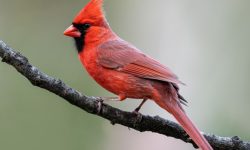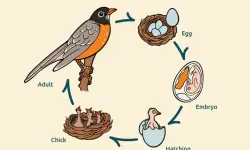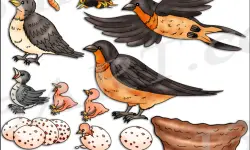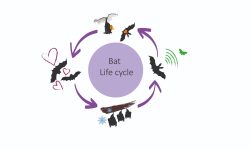California is more than a golden land of beaches and mountains—it is a haven for an astonishing variety of birdlife, including some of the most captivating woodpeckers in North America. These birds, famous for their rhythmic drumming and tree-scaling acrobatics, are not only visually arresting but serve critical roles in maintaining forest health. Their daily activities sculpt the ecosystem: excavating nesting cavities that shelter other species, controlling insect populations, and even spreading fungi and seeds.
In this richly illustrated guide, we explore eight of California’s most spectacular woodpecker species. With each, you’ll learn not only how to identify them by sight and sound but also understand their ecology, behaviors, and the unique niches they occupy in the wild Californian landscape.
Acorn Woodpecker: Nature’s Comedian and Strategic Planner

Dressed Like a Clown, Behaving Like a Genius
Among North American woodpeckers, the Acorn Woodpecker stands out not just for its appearance but also for its remarkable intelligence. With its striking facial pattern—a bright red crown, stark white forehead, and a black mask that stretches around glaringly pale eyes—it looks like a bird painted for comic relief. Its perpetual wide-eyed stare gives it the expression of a startled cartoon character. Yet behind this whimsical appearance lies a bird of impressive intellect and extraordinary social complexity.
Far from being a solitary creature, the Acorn Woodpecker thrives in bustling, cooperative family groups. These clans operate like efficient teams, collectively managing one of nature’s most fascinating food storage systems. They drill countless holes into dead trees, telephone poles, or wooden structures to create what are known as “granary trees”—living food banks filled with thousands of acorns. These caches aren’t just short-term supplies; they represent long-term investments, carefully maintained, defended, and even inherited across generations. Some granary trees can contain tens of thousands of acorns and are used by the same family group for decades. This behavior shows a deep understanding of both seasonal food availability and the importance of long-term planning—a rare trait in the animal kingdom.
Telltale Signs and Sounds
If you’re walking through oak woodlands and hear something that sounds like laughter echoing from the trees, you’ve probably stumbled into Acorn Woodpecker territory. Their unique, machine-gun-like call—often described as “waka-waka-waka”—is a constant background track in the areas they inhabit. They’re highly vocal birds, using a wide range of calls to coordinate within their group and communicate warnings or excitement.
Visually, they’re easy to identify if you know what to look for. Watch for medium-sized black-and-white birds zipping through the canopy or perched upright on tree trunks. They often hang around utility poles or dead trees, which are peppered with tiny, perfectly round holes. These holes are the entrances to their meticulously organized granaries. A close look will reveal their telltale face: white forehead, black mask, and that unmistakable red cap, giving them a clown-like but captivating appearance.
Northern Flicker: The Ground-Dwelling Rebel
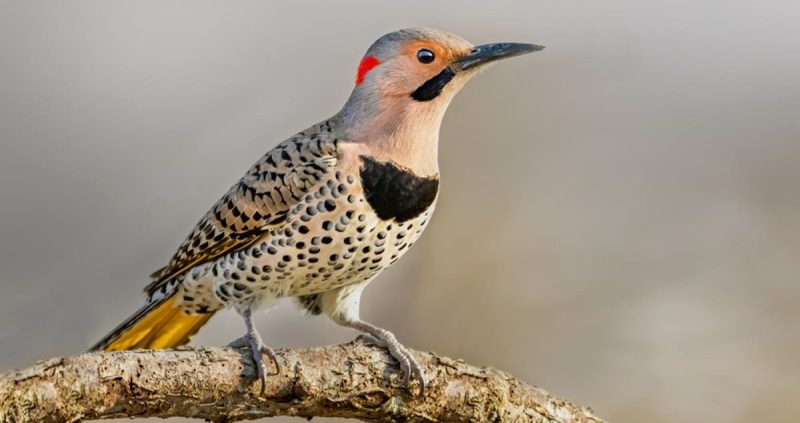
A Woodpecker That Hunts from the Earth
Among a family of tree-huggers, the Northern Flicker is something of a rebel—a woodpecker that breaks the rules. While its relatives cling to tree trunks and hammer away at bark, the Flicker often chooses the forest floor instead. It spends more time on the ground than any other woodpecker species, using its strong, chisel-like bill not to peck at wood, but to probe into loose soil in search of its favorite prey: ants and beetles. Despite its unusual habits, the Northern Flicker still sports the classic woodpecker toolkit: a sturdy bill, stiff tail feathers for balance, and zygodactyl feet—two toes pointing forward and two backward—perfect for gripping bark when it does decide to go vertical.
In California, the Red-shafted Flicker is the form most commonly seen. Its overall appearance is modest at first glance, with a coat of soft, earthy browns speckled with black bars and dots. But when it takes flight, it erupts in color—a stunning salmon-red flash bursts from beneath its wings and tail. This hidden vibrancy is one of its most striking features. Male Red-shafted Flickers also wear a bold red mustache, a vivid splash of color that adds a sense of swagger to this already stylish bird.
Behavior That Breaks the Mold
Unlike most woodpeckers, Northern Flickers rarely drum on trees or surfaces to communicate. Instead, they express themselves through distinctive vocalizations—a sharp “kleer” call that slices through the air, or a rolling rattle that spirals upward in pitch, echoing across open landscapes. These sounds serve as territorial calls and mate-attracting songs, resonating through lawns, meadows, and woodland edges, where Flickers are most often found.
Watch carefully, and you may catch one foraging in the open, digging furiously with its powerful bill, tossing dirt aside as it pursues ant colonies beneath the surface. During flight, the bird’s white rump patch becomes an unmistakable field mark—flashing like a signal as it glides between trees or across grassy clearings. With its ground-loving habits and unexpected bursts of color, the Northern Flicker is a woodpecker that consistently defies expectations.
Nuttall’s Woodpecker: California’s Own
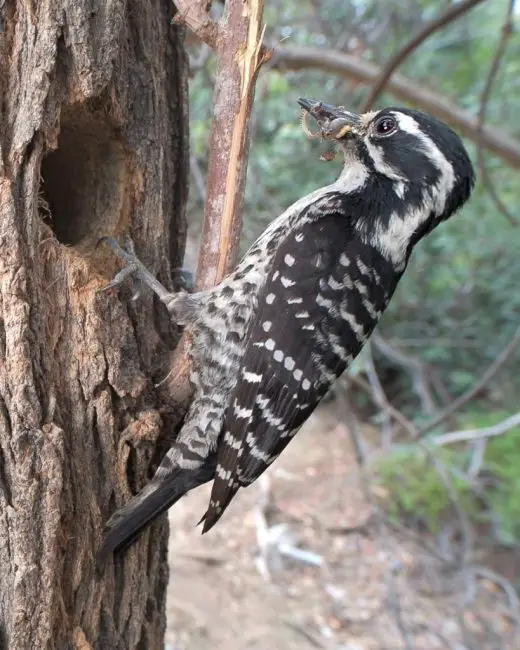
Small, Secretive, and Found Nowhere Else
The Nuttall’s Woodpecker is a bird of quiet charm—subtle in appearance, yet deeply rooted in the identity of its home. Found nowhere else on Earth, this is the only woodpecker species endemic to California, making it a treasured part of the state’s natural heritage. It shows a strong preference for oak woodlands and riparian corridors—the lush, tree-lined waterways that thread through the coastal ranges, especially in central and southern California.
Physically, the Nuttall’s Woodpecker carries a refined and compact look. Its back is decorated with clean black-and-white bars, resembling the rungs of a miniature ladder. This pattern blends seamlessly into the dappled light of oak canopies. Its face is marked with crisp black-and-white lines, and males are topped with a bright red crown patch, a small but vivid signal among the leaves. Though tiny in size, this woodpecker is full of energy—its quick, darting movements along thin branches make it a challenging bird to spot for beginners.
Despite its elusive nature, the Nuttall’s leaves clues for the attentive observer. One of the best ways to detect its presence is by tuning in to its sharp, metallic “pit-pik” call, a sound that cuts clearly through the quiet of woodland mornings. And once you learn to recognize its bold facial mask—a sharp black slash across its face—you’ll find it easier to identify even amid dense foliage.
More than just a bird, the Nuttall’s Woodpecker is a symbol of California’s rich biodiversity. Its narrow range and specific habitat needs make it particularly vulnerable to habitat loss, especially as oak woodlands face increasing pressure from development and drought. Protecting this species means preserving not only a unique bird, but also the delicate ecological web it depends on.
The Drummer of the Canyon Shadows
The Nuttall’s Woodpecker may be one of the more soft-spoken members of the bird world, but it knows how to make itself heard when it counts. Rather than relying on loud calls, it communicates through short, rapid bursts of drumming—a form of Morse code tapped out on hollow wood—and quick, metallic “pit-pik” notes that pierce the quiet air. These sounds, though subtle compared to the bold percussion of larger woodpeckers, are precise and efficient, designed for short-distance communication in the dense tangle of oak branches.
If you find yourself hiking through a dry California canyon lined with valley oaks, sycamores, or willows, stop for a moment. Let the shadows settle and your eyes adjust. Then, scan the mid-level branches, where this small woodpecker often works. You might glimpse a quick, black-and-white blur as it flits between limbs, or watch as it zigzags nimbly up a trunk, probing crevices for insects and larvae.
Though small and inconspicuous, the Nuttall’s moves with purpose and precision. It blends into the sun-dappled canopy, becoming part of the rhythm of the canyon itself—a shadowed drummer in a sunlit orchestra of leaves, bark, and breeze.
Downy Woodpecker: The Diminutive Dynamo

North America’s Smallest Woodpecker
Tiny yet fearless, the Downy Woodpecker is a bird that defies expectations. Barely larger than a sparrow, it’s the smallest woodpecker species in North America, yet it displays all the classic traits of its larger cousins—drumming rituals, bark-foraging behavior, and the ability to excavate perfectly round nest cavities in tree trunks. Despite its size, the Downy is a confident and capable presence in any woodland setting.
In California, you’ll find this compact bird in a variety of habitats: from shady river corridors to suburban backyards, and from wooded parks to the edges of mountain forests. Wherever there are trees, there’s a good chance a Downy is quietly going about its work—tapping, probing, and fluttering from branch to branch with energetic precision.
Its plumage is a study in contrast: a clean black-and-white pattern that helps it blend into tree bark while also making it easy to recognize. The male’s head is adorned with a small red patch on the nape—a splash of color that distinguishes him from the female. One of the Downy’s most notable features is its short, dainty bill, which is only about a third the length of its head. While this may give the bird a gentle or delicate appearance, it belies a nature that is anything but timid.
In winter, Downy Woodpeckers often join mixed-species flocks, associating with birds like chickadees and nuthatches. Within these groups, the Downy frequently punches above its weight—holding its ground at feeders, darting in confidently, and sometimes even assertively driving off larger birds to claim its place. Its small size offers an advantage too, allowing it to forage in tiny crevices and on twigs that heavier woodpeckers cannot navigate.
Charming, adaptable, and full of personality, the Downy Woodpecker proves that in the bird world, size does not dictate strength—and that even the smallest drummer can make itself heard.
Listen for the Whispering Drummer
While the Downy Woodpecker may be small, it still takes part in one of the most iconic behaviors of its kind: tree drumming. But unlike the deep, thunderous knocks of larger species, the Downy delivers a rapid, delicate roll—a faster and softer rhythm that seems almost whispered into the wood. You might miss it if you’re not paying close attention, yet in quiet woodlands or peaceful suburban groves, this whispering drumbeat can stand out like a heartbeat in the trees.
Its vocalizations are equally subtle but expressive. The Downy’s call is a descending, whinny-like trill, often described as sounding playful or curious. This soft, spiraling call adds a whimsical, almost cheerful tone to its presence, making it as pleasant to hear as it is to watch.
For birdwatchers, one of the key challenges is distinguishing the Downy from its near-twin: the Hairy Woodpecker. Both birds wear the same black-and-white plumage with similar facial markings and back patterns, but size and bill shape offer the clearest clues. The Downy is noticeably smaller, and its bill is much shorter—only about a third the length of its head—giving it a more compact, gentle profile. In contrast, the Hairy Woodpecker has a chisel-like bill nearly as long as its head, lending it a more imposing appearance.
So when you’re out in the field and see a small black-and-white woodpecker flitting through tree limbs, listen for the light tapping, the soft laughter of its whinny call, and look closely at the bill. If it’s short and neat, you’ve likely found yourself in the company of the Downy—a gentle drummer with a subtle but unmistakable voice in the forest.
Hairy Woodpecker: The Downy’s Rugged Twin
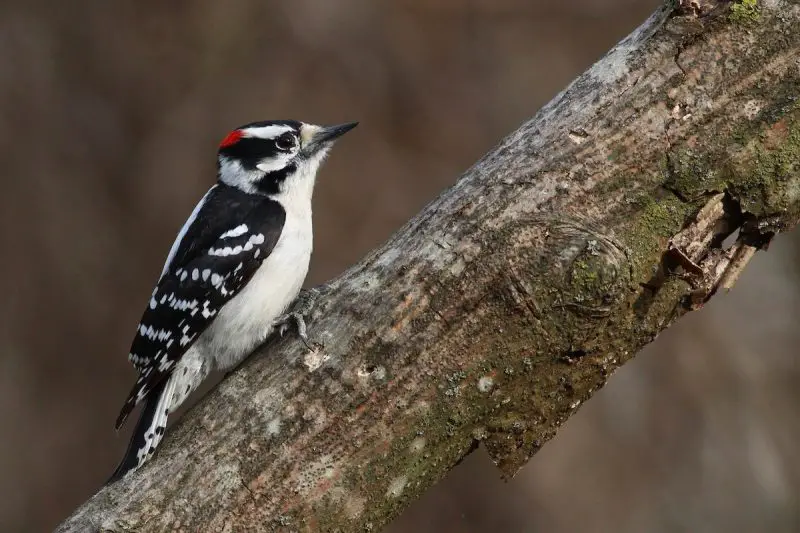
A Larger, More Forceful Lookalike
At first glance, you might mistake a Hairy Woodpecker for a Downy. The coloration is nearly identical: bold black-and-white barring, facial stripes, and red crown spot in males. But take a second look. The Hairy is bulkier, with a longer, dagger-like bill and a more robust stance.
It inhabits mature forests, especially those with dead trees for nesting and foraging. It feeds on beetle larvae and ants hidden deep within bark, often heard before it’s seen thanks to its sharp “peek!” calls and slow, deliberate drumming.
When Size Matters
Unlike the Downy’s soft taps, the Hairy’s drumming reverberates with force. Its tail feathers are stiff and square, helping it balance vertically against tree trunks. Spotting one means you’re likely in healthy forest habitat, rich with decaying wood and complex canopy layers.
Lewis’s Woodpecker: The Iridescent Aerialist
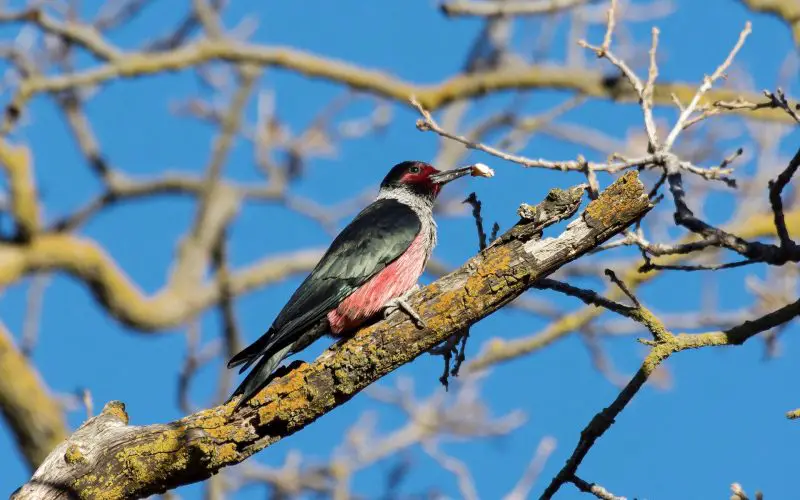
A Woodpecker That Flies Like a Crow
Lewis’s Woodpecker is a radiant anomaly. With a dark green-black back, shimmering pink belly, gray collar, and deep red face, it looks more like a tropical bird than a North American woodpecker. Its behavior is equally unique: instead of climbing trees and drumming, it flies out from perches to snatch insects in mid-air, more like a flycatcher or crow.
Named after Meriwether Lewis, this species thrives in open pine forests, especially post-fire landscapes with standing snags. It is a bird of recovery, thriving where others falter. This ecological resilience makes it a symbol of rebirth in California’s fire-adapted ecosystems.
Spotting the Soaring Jewel
Watch for its slow, buoyant flight—broad wings flapping lazily as it glides between snags. Though often silent, Lewis’s Woodpeckers may give low chattering sounds or gentle calls. Their unique coloration and flight silhouette make them unmistakable once seen.
White-headed Woodpecker: The Alpine Sentinel

High-Elevation Specialist of the Pines
With its stark black body and snow-white head, the White-headed Woodpecker is one of California’s most visually dramatic birds. It is found almost exclusively in montane conifer forests at elevations above 5,000 feet. This bird is an emblem of the Sierra Nevada, where it quietly flits among ponderosa and Jeffrey pines.
Unlike its insect-hunting relatives, the White-headed Woodpecker has adapted to a diet rich in pine seeds. It pries apart pine cones and flakes bark with surgical precision. Its movements are slow and deliberate, and its vocalizations—soft “pee-dink” notes—are subtle, making it a challenge to detect without patience.
Why It’s Worth the Hike
Reaching its habitat often requires effort: a drive into the mountains, a hike into remote pine groves. But the reward is memorable. The contrast of its ghostly white head against the dark bark of high-altitude forests leaves a lasting impression on even the most casual birder.
Red-breasted Sapsucker: The Scarlet Engineer
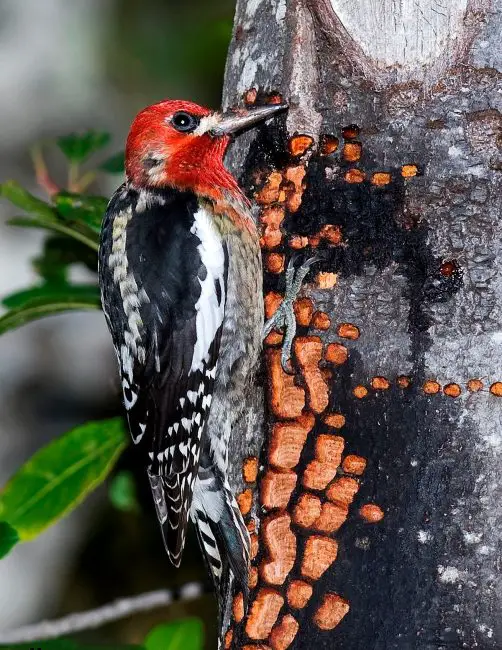
Painting Trees with Purpose
The Red-breasted Sapsucker is both an artist and an engineer. Its brilliant red head and breast glow like a lantern in the forest understory. Below that, a black back with white patches and a yellowish belly complete its striking appearance. Found along the coast and into the Sierra foothills, this bird drills neat rows of sap wells in trees such as alder, birch, and apple.
These wells don’t just feed the sapsucker—they attract other birds, insects, and even hummingbirds. In this way, the Red-breasted Sapsucker influences its entire microhabitat, creating a seasonal buffet that benefits many species.
The Signature of a Sapsucker
Even if you don’t see the bird, you may find its work: horizontal rows of tiny holes oozing sap. These sap wells are unmistakable signs of its presence. Its vocalizations are soft and mewing, often going unnoticed unless you’re actively listening.
Conclusion: California’s Woodpecker Symphony
The woodpeckers of California are more than just drummers in the forest symphony. They are builders, foragers, strategists, and survivors. Each species adds a distinct note to the state’s ecological melody—from the social complexity of the Acorn Woodpecker to the fire-adapted tenacity of Lewis’s Woodpecker, and the alpine grace of the White-headed.
By learning to identify and understand these birds, you not only enhance your birdwatching experience, but also deepen your connection to the living, breathing ecosystems that make California so extraordinary. Keep your binoculars close and your ears open—the next tap on bark or flutter of wings might just reveal one of nature’s most fascinating architects.

